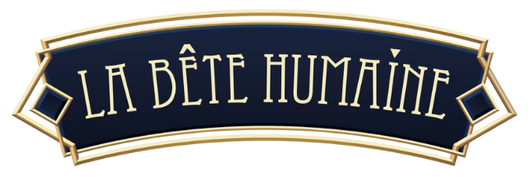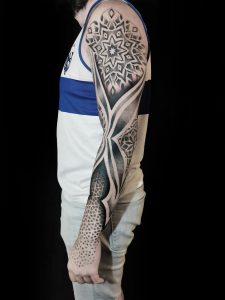Fond of freehand tattooing, the Parisian artists at La Bête Humaine share everything about this method: definition, steps, advantages, and examples!
Fans of freehand tattooing, the Parisian artists of La Bête Humaine tell you everything about this method: definition, steps, benefits, and examples!
What is freehand tattooing?
Freehand tattooing, sometimes spelled as two separate words « free hand », refers to a tattoo done without a stencil, meaning the tattoo artist doesn’t first print your design on carbon paper before applying it to your skin. With a freehand tattoo, the artist directly draws your tattoo with a marker on your skin, and after getting your approval, proceeds to tattoo.
What are the different stages of a freehand tattoo?
Here are the various stages involved in getting a freehand tattoo:
- You contact your tattoo artist, typically via email, to discuss your vision. To provide clearer guidance, you can send them some reference images, tattoos you love, or even a photo of the area to be tattooed if it already has other pieces.
- Once the appointment is set, your tattoo artist shaves any possible hair or fuzz covering the tattoo area and disinfects it.
- With your skin prepped, the artist creates a preliminary sketch, meaning they’ll draw your tattoo with a light marker. Making adjustments is much easier and less « smudgy » than with a dark marker.
- Once this initial sketch is approved, the artist draws a final outline using a dark marker.
- Everything is set: your tattoo artist brings out their tattoo gun and tattoos you, following the lines and indications made with the marker!
- When your session is over, you apply all the usual tattoo aftercare: clean with antiseptic solution, apply ointment, etc.
What are the advantages of freehand tattooing?
Suitable for all styles, freehand tattooing offers numerous benefits for the individual getting inked! The first and primary advantage is that it allows for the optimal adaptation of the tattoo to the person’s body. With it, the artist can truly honor the lines and contours of your anatomy, flow with your movements, work with your unique body shape, and, most importantly, adapt to it. For instance, the artist will consider if your tattoo near the elbow distorts when you bend your arm, or if the face they’re inking onto your skin doesn’t look distorted with every skin movement…
The second benefit of freehand tattooing is that it doesn’t limit the artist’s creativity. When your tattoo artist isn’t confined to a predefined design, they can offer more suggestions and interact better with your skin! A true joy for experienced artists.
Lastly, the third advantage of freehand tattooing is that it’s particularly recommended for:
- covers
- fillers
A cover, as the name suggests in proper English, is an overlay; it involves covering an old tattoo you want to hide with a new piece. And, freehand is especially suited for this kind of work because it allows the artist to reuse a line or feature from the old tattoo for the new one. For instance, the faded fin of an old fish tattoo might, thanks to freehand, transform into the luminous wing of a bird for a new piece…
A filler, on the other hand, refers to a tattoo that fits between two existing tattoos (it comes from the verb ‘to fill’). When it’s about fitting between several pieces and, especially, conforming to their contours without betraying them, freehand tattooing is the go-to choice and proves to be extremely effective.
What are the drawbacks of freehand tattooing?
But stencil tattooing still has a role to play and has its own set of benefits! The first and most obvious one is that with a pre-drawn design, the person getting tattooed can better visualize what their final tattoo will look like even before the carbon paper is applied to their skin – though some slight differences might appear in the finished tattoo (tattoo artists are craftsmen, not photocopiers!).
The second advantage: stencil tattooing is especially recommended for patterns, meaning designs that will be repeated identically multiple times in the same piece. In this case, using carbon paper guarantees harmony.
Lastly, the third benefit of carbon tattooing is that it allows for a significant time-saving on certain tattoos, especially for very fine geometric designs.
Does a freehand tattoo cost more?
Let’s debunk some misconceptions: a freehand tattoo is neither more expensive nor cheaper than a stencil tattoo! Just like tattoos done with carbon paper, those done freehand have their cost determined by the size of the project, its technical complexity, and the time spent on the design. Discuss it directly with your artist!
Example of a freehand tattoo
In addition to a few pieces showcased below in the gallery, all created within the walls of the Parisian studio La Bête Humaine, we invite you to watch an example video. Here, our tattoo artist Lola Kaa designs a rose filler on a client’s arm, just a few centimeters from the elbow!
Who should you see for your freehand tattoo at La Bête Humaine?
At 5 rue Pierre Chausson, three regularly indulge in freehand tattooing:
- Pierre-Gilles Romieu: biomechanical designs are particularly suited for this method (contact him at: pgromieu@gmail.com)
- Lola Kaa: freedom combined with neo-traditional designs influenced by Japanese aesthetics in black and gray (contact her at: art.lolakaa@gmail.com)
- Baybay Blondy: for geometric and ornamental styles infused with dotwork (contact at: guest.lbh@gmail.com)
Want to meet us in person? La Bête Humaine is open every day (except Sundays) from 10 a.m. to 7 p.m.!

